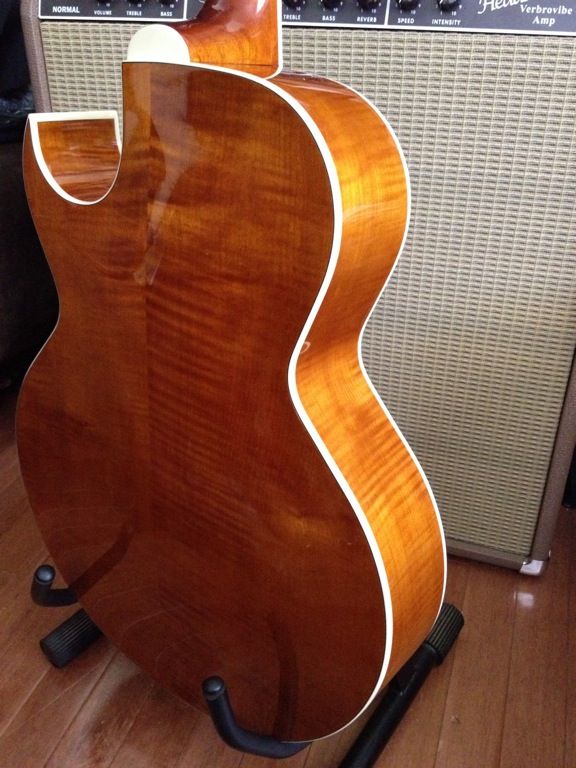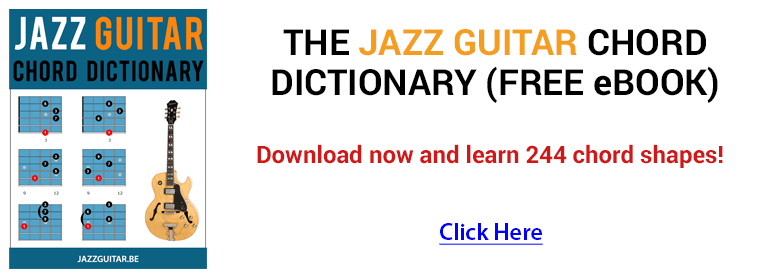-
The bone nut on the Loar LH650 is only 1 3/4" but the neck feels like a nylon string neck, which of course I'm not used to.
Any suggestions on teaching yourself to get comfortable with a neck width you're not accustomed to?
My mitts are big enuf...that's not the issue...it's just a neck and width that's new.
ThX in advance!Last edited by 2bornot2bop; 09-25-2013 at 06:53 PM.
-
09-25-2013 05:28 PM
-
I don't really think you can teach yourself to get comfortable with it. You would train yourself to become comfortable with it over time out of familiarity. But, I would think you'd need to stay away from the 1-11/16" guitars for a while. I personally have no trouble going from 1-11/16" to 1-3/4". I usually adapt pretty well after about 10 to 15 minutes. But, the SSB SE I sold to "The Dr." has a 1-13/16" nut width. I Loved the guitar's tone and its look in SSB. But, I couldn't bond with the width. It's typically a "finger style" width and I seldom play finger style . . . sometimes hybrid and sometimes thumb . . but, hardly ever pure finger style.
 Originally Posted by 2bornot2bop
Originally Posted by 2bornot2bop
I also sold him an absolutelyt beautiful GE, with a 1-3/4" nut width . . but a VERY full D shaped neck with huge shoulders. I deeply regret selling that guitar. One of the best GE's I've ever owned or played. I think I might have gotten used to the neck if I gave it more time.
Here's the GE. LORD!! I wish I had this guitar back in my stable!

-
I think there are 2 basic options:
1. ONLY play the wide neck for about 3 months, do NOT play anything else. This includes practice, jams and gigs.
2. Alternate between various neck widths using a different guitar everyday. This includes practice, jams and gigs. Especially do this for gigs.
Neck widths/shape simply do NOT matter to me anymore. I have a Loar, a classical, a pair of skinny neck Eastman's, Godin Kingpin, Gretsch G100CE, a giant neck JWC gypsy guitar, strats, teles, Larrive Parlor guitar, Tacoma Papoose, tenor guitar, 5-string banjo, etc. It takes me no more than 3-5 seconds to adjust between any of these guitars. As long as the action is good, so am I
OTOH, I'm currently struggling with different pick sizes, and am using method 1 above with a 7mm Wegen Later, I'll use method 2 with various picks.
Later, I'll use method 2 with various picks.
-
Keep your thumb along the centerline at the back of the neck as much as possible.
Bend your wrist and keep it loose.
Keep your elbow fairly close to your body.
Play with a lot of arch in your fingers and focus on playing on the tips.
Try to finger the strings lightly and close to the fret whenever possible.
-
Play the hell out of it. my guitars range from 1 5/8 to over 2"...if I haven't played a certain one in a while it can feel weird...but an hour of steady play and it feels like home again.
Jim's advice would normally be spot on, but the Loar's have a pronounced V shaped neck. It just takes time...
-
Yes, play the guitar. I love going to my classical guitar and playing. No problems there. And I loved my Johnny Smith, and Kay Thin Twin, with their big wide necks. My L5 puts me in the same place.
Unless you are trying to "shred", the bigger necks are fast, and I think I learned to be a better player for having them. Great for chording, and practicing.
-
I know you're bummin. I was bummin when I learned Mark had sold it before I even learned she was for sale!!! Someone got a steal, and a rare bird....
 Originally Posted by Patrick2
Originally Posted by Patrick2

Well, the guitars too good to pass on, so I'm committed to learning to play this one...you'll hear why once I've got it under my fingers. Think the perfect balance between wood and pickup.
Lucky for me...I don't use a pick on jazz archtops, only my flattops if I'm strummin' some George Harrison. Originally Posted by D.G.
Originally Posted by D.G.
Many thx Jim! 'Playing on the tips' would be helpful playing period. Originally Posted by Jim Soloway
Originally Posted by Jim Soloway
This LH650 doesn't have a V-shaped neck. Wassup with that? R U referring to the base of the neck as it attaches to the guitar? Not here....but it's as fat as a nylon string...well, fat due to my inexperience. Thx all for the encouragement! Originally Posted by mr. beaumont
Originally Posted by mr. beaumont

Last edited by 2bornot2bop; 09-25-2013 at 07:09 PM.
-
No, the profile itself...interesting...naybe they only did that on the acoustic models.
-
Keep the guitar for more than a week! (For starters)

Repetition builds the muscle memory needed for almost any new instrument mechanics. I spent a year playing nothing but flamenco on proper flamenco guitars, and it changed my neck adaptation skills forever (plus many other techniques).
-
Time on the instrument. Seriously. Once you get used to the wider nut, you'll prefer it.
-
Greg .. I think the first and most important thing you need to do . . IMO . . is probably going to be the hardest. Stop reminding yourself every time you pick up the guitar that it has a bigger and wider neck.
Then, as mentioned here before by others and by me . . . don't touch any other guitar for at least a couple of weeks. And just stop focusing on how big the neck is. Just play it like it's the only guitar you have and it's the only guitar you'll ever have.
-
Yep just play it and don't think about it too much.
-
 Originally Posted by Jim Soloway
Originally Posted by Jim Soloway
Jim - I'm curious about the elbow position part of your advice. Please explain, and thanks in advance.
Cheers.
-
The objective when playing on a wider fingerboard (or really any fingerboard when your using something approximating classical left hand position) is to keep your fingertips above the level surface of the fingerboard. If your elbow floats out from the side of your body, it causes your hand to rotate down, pulling your fingers off the surface of the fingerboard and your thumb to rotate up towards the upper edge of the fingerboard. The only way to move your elbow away from your body is if the entire arm moves as a single unit so the hand and forearm remain in a single constant position to the elbow (as most classical players do), but in the absence of true classical technique, the best alternative is to simply try to keep the elbow close to the body which allows the forearm to pivot back and forth, bending the wrist further forward as your hand moves up the fingerboard towards the body and flattening the wrist more as your hand moves down the fingerboard towards the nut. That keeps the fingers in playing position above the board all the way from the nut to above the octave, providing increased fingerboard coverage.
BTW, all of my primary guitars for the last three or four years have been 1 13/16" at the nut to 2 3/16 spacing at the bridge. My hands are not huge but I found that to be an incredibly comfortable and natural set up from the first time I played it. In fact, the first time I played that spacing it was also on guitar with a 27" scale length and it still felt comfortable to me.Last edited by Jim Soloway; 09-26-2013 at 12:16 AM.
-
The LH-350 and LH-650 have a vintage C profile while the other Loar archtops have a vintage V profile.
 Originally Posted by mr. beaumont
Originally Posted by mr. beaumont
(I think maybe the 350 and 650 used to have V profile too).
I own both a LH-300 and a LH-650 and the necks feel rather different. I think the 650 is much easier to play.
-
Thanks Jim. I was thinking about classical technique and could not square that with your advice.
-
2Bop,
The many Eastmans you've owned had a 1 3/4 nut, but you never perceived it as a problem? Speaks to the Loar's neck shape.
-
The elbow at the side and the neck pointing up at 45 degrees allow the most comfortable arching of the hand over the fretboard. Optimally the relationship of the hand, wrist and elbow don't change going up and down the neck. The hand must change as you move vertically while the wrist has little flexion and extension.
-
You caught that huh! Yes, only about 10 Eastman's. None of those ever presented themselves as being a s-t-r-e-t-c-h.
 Originally Posted by ESCC
Originally Posted by ESCC
Perhaps it's this combo with this particular C neck shape that's creating the challenge. At this point I'm simply happy nobody bought it when it was listed. Okay, I'm not touching any others for at least a month...I'll report back. Time to go play that narrow neck '650.
-
I am worried about going in the other direction, always had a wide neck guitar and want to get a tele...I found a few Warmouths on E-bay, teles with the wider necks....would like to stick with a neck I'm confortable with.....
-
Yeah, I play a wide variety of styles and own a wide variety of guitars. For the past several month I've been playing only jazz and latin (archtop and nylon). The other day I picked up my PRS to noodle a few lines, and the neck felt too skinny and cramped.
 Originally Posted by artcore
Originally Posted by artcore
-
It's hard to find a Fender Tele with a wide neck, but as you know, it's a bolt-on so you can swap it!
 Originally Posted by artcore
Originally Posted by artcore
Warmath and USACG both make excellent custom necks.
I bought a G&L ASAT Special (my avatar), ordered with a 1 3/4" nut. It has pickups that are cleaner/more hi-fi sounding than stock Tele pups, and the bridge is nicer than the standard Tele boxed steel bridge, in my opinion. For your consideration...
-
How much was the G@L?.....
-
$1462 plus tax. The ASAT Special starts at $1500 MSRP ($1125 street). Substituting another another neck profile adds $50 ($37.50). I added a few more options onto my guitar including an ebony fretboard.
 Originally Posted by artcore
Originally Posted by artcore
Here's a guitar builder with prices you can play with: http://www.americanguitarboutique.net/Guitar_index.htmlLast edited by BigDaddyLoveHandles; 10-05-2013 at 01:02 AM.
-
What kind of 'advice' could there be, other than to just play it a lot?




 Reply With Quote
Reply With Quote



Seeking
Yesterday, 03:50 PM in For Sale